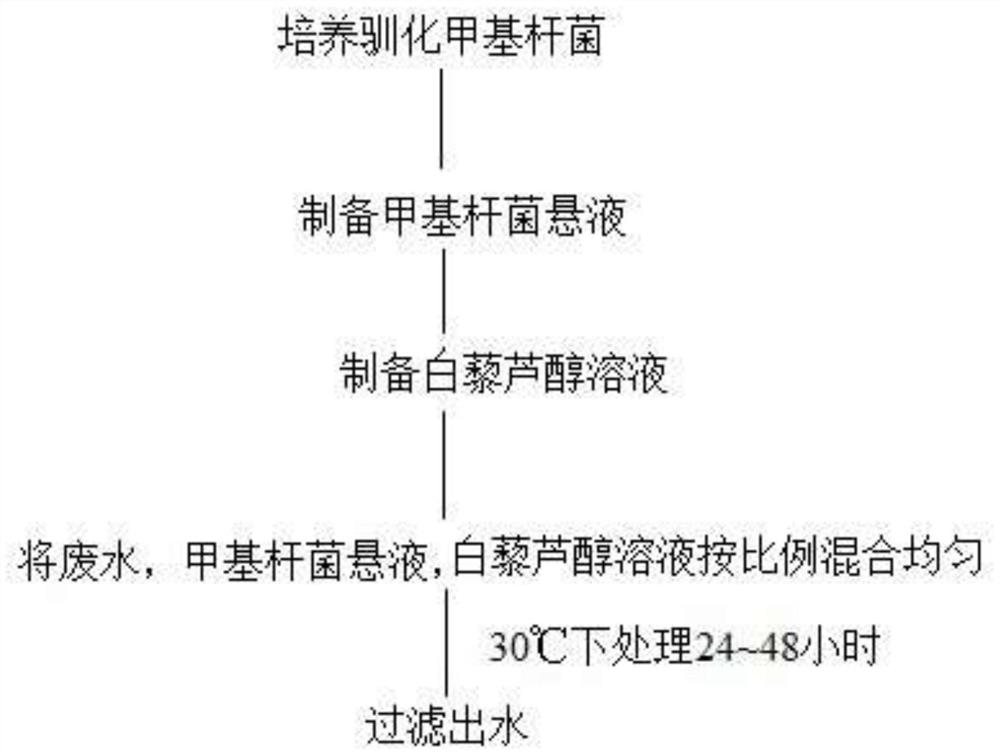Resveratrol composite bacterial agent for treating high-concentration pahs wastewater and its application method
A technology of resveratrol and compound bacterial agents, applied in the direction of microorganism-based methods, chemical instruments and methods, biological water/sewage treatment, etc., can solve the problem of low degradation efficiency of PAHs
- Summary
- Abstract
- Description
- Claims
- Application Information
AI Technical Summary
Problems solved by technology
Method used
Image
Examples
Embodiment 1
[0050] Treatment of phenanthrene-containing wastewater with resveratrol-Methylobacterium complex bacterial agent. The dosage of the bacterial agent is waste water: agent 1: agent 2 volume ratio 200:1:1. The results showed that after 24 hours of treatment, the removal rate of phenanthrene reached 48.5%, which was 336% higher than that of no compound bacterial agent, and 38.3% higher than that of Methylobacterium alone. Analyze the removal rate of polycyclic aromatic hydrocarbons by high performance liquid chromatography (HPLC), figure 2 is the result graph of the analytical instrument.
Embodiment 2
[0052] Treatment of phenanthrene-containing wastewater with resveratrol-Methylobacterium complex bacterial agent. The dosage of the bacterial agent is waste water: agent 1: agent 2 volume ratio 100:0.5:1. The results showed that the removal rate of phenanthrene reached 51.2% after 48 hours of treatment, which was 201% higher than that of no bacterial agent, and 23.7% higher than that of Methylobacterium alone. The removal rate of polycyclic aromatic hydrocarbons was analyzed by HPLC, image 3 is the result graph of the analytical instrument.
Embodiment 3
[0054] Treatment of wastewater containing phenanthrene and acenaphthene with resveratrol-Methylobacterium complex bacterial agent. The dosage of the bacterial agent is waste water: agent 1: agent 2 volume ratio 200:1:1. After 48 hours of treatment, the removal rates of phenanthrene and acenaphthene reached 57.0% and 61.5%, respectively, which were 235% and 232% higher than those without bacterial agents, and 35.7% and 27.3% higher than those with Methylobacterium alone. The removal rate of polycyclic aromatic hydrocarbons was analyzed by HPLC, Figure 4 is the result graph of the analytical instrument.
PUM
| Property | Measurement | Unit |
|---|---|---|
| concentration | aaaaa | aaaaa |
Abstract
Description
Claims
Application Information
 Login to View More
Login to View More - R&D
- Intellectual Property
- Life Sciences
- Materials
- Tech Scout
- Unparalleled Data Quality
- Higher Quality Content
- 60% Fewer Hallucinations
Browse by: Latest US Patents, China's latest patents, Technical Efficacy Thesaurus, Application Domain, Technology Topic, Popular Technical Reports.
© 2025 PatSnap. All rights reserved.Legal|Privacy policy|Modern Slavery Act Transparency Statement|Sitemap|About US| Contact US: help@patsnap.com



